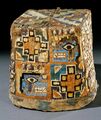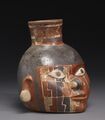Social:Wari culture
The Wari (Spanish: Huari) were a Middle Horizon civilization that flourished in the south-central Andes and coastal area of modern-day Peru, from about AD 500 to 1000.[1]
Wari, as the former capital city was called, is located 11 km (6.8 mi) north-east of the modern city of Ayacucho, Peru. This city was the center of a civilization that covered much of the highlands and coast of modern Peru. The best-preserved remnants, beside the Wari Ruins, are the recently discovered Northern Wari ruins near the city of Chiclayo, and Cerro Baul in Moquegua. Also well-known are the Wari ruins of Pikillaqta ("Flea Town"), a short distance south-east of Cuzco en route to Lake Titicaca.
However, there is still a debate whether the Wari dominated the Central Coast or the polities on the Central Coast were commercial states capable of interacting with the Wari people without being politically dominated by them.
History
Early on, the Wari expanded their territory to include the ancient oracle center of Pachacamac, though it seems to have remained largely autonomous. Later, the Wari became dominant in much of the territory of the earlier Moche and later Chimu cultures. The reason for this expansion has been debated; it is believed to have been driven by religious conversion, military conquest, or the spread of agricultural knowledge (specifically terrace agriculture).
As a result of centuries of drought, the Wari culture began to deteriorate around 800 AD. Archeologists have determined that the city of Wari was dramatically depopulated by 1000 AD, although it continued to be occupied by a small number of descendant groups. Buildings in Wari and in other government centers had doorways that were deliberately blocked up, as if the Wari intended to return, someday when the rains returned.[2] By the time this happened, though, the Wari had faded from history. In the meantime, the dwindling residents of the Wari cities ceased all major construction. Archaeological evidence shows significant levels of interpersonal violence, suggesting that warfare and raiding increased amongst rival groups upon the collapse of the Wari state structure.[3] With the collapse of the Wari, the Late Intermediate Period is said to begin.
Government
Little is known about the details of the Wari administrative structure, as they did not appear to use a form of written record, but the emphasis on homogeneous administrative architecture and evidence for significant social stratification suggests a complex sociopolitical hierarchy.
The discovery in early 2013 of an undisturbed royal tomb, El Castillo de Huarmey, offers new insight into the social and political influence of the Wari during this period. The variety and extent of the burial items accompanying the three royal women indicate a culture with significant material wealth and the power to dominate a significant part of northern coastal Peru for many decades.[4]
Another example of burials helping to establish social stractifications is in the city of Conchopata where the remains of more than 200 individuals have been found. This city is located about 10 km from the capital city. Earlier it was believed that this was a city of potters, but the burials suggest otherwise. They show that there were servants, middle-class, elite, and even perhaps low kings or governors.[5]
Architecture
During its expansion period, the Wari state established architecturally distinctive administrative centers in many of its provinces. These centres are clearly different from the architecture of Tiwanaku, which is believed to have been a more federalized state by some scholars (such as John W. Janusek). Wari architecture often had large stone enclosures with no windows and just a few entries, the sites had no central place for people to gather for ritual gatherings. While the Tiwanaku had a more open architectural plan that could accommodate multiple people at once. Using these administrative centers, the Wari greatly influenced the surrounding countryside. Scholars were able to look at the Inca's to reconstruct some of the architecture of the Wari. Along the Inca highway system several Wari provincial sites were found, suggesting that the Wari used a similar road network. They also created new fields with terraced field technology, which the Inca's also drew inspiration from.[6]
Art
The Wari are particularly known for their textiles, which were well-preserved in desert burials. The standardization of textile motifs serves as artistic evidence of state control over elite art production in the Wari state.[7] Surviving textiles include tapestries, hats and tunics for high-ranking officials. There are between six and nine miles of thread in each tunic, and they often feature highly abstracted versions of typical Andean artistic motifs, such as the Staff God. It is possible that these abstract designs served "a mysterious or esoteric code to keep out uninitiated foreign subjects" and that the geometric distortions made the wearer's chest appear larger to reflect their high rank.[7]
The Wari also produced highly sophisticated metalwork and ceramics, with similar designs to the textiles. The most common metals used were silver and copper, though gold Wari artifacts also survive. The most common metal objects were qiru, bowls, jewelry, mummy bundle masks, mantle pins, and sheet figures who demonstrate how the tunics were worn.[7] Ceramics were typically polychrome and frequently depicted food and animals. Conchopata appears to have been the ceramic center of Wari culture given the high quantities of pottery tools, firing rooms, pit kilns, potsherds, and ceramic molds. There is evidence that ceramics were ritually smashed, sometimes accompanying human sacrifice.[7]
Gallery
See also
- Wari Empire
- Willkawayin
- Tiwanaku
- Tiwanaku empire
- Middle Horizon
- Pocra culture
- Chuqi Pukyu
References
- ↑ Susan E. Bergh (2012). Wari: Lords of the Ancient Andes. Thames & Hudson. ISBN 978-0-500-51656-0. https://books.google.com/books?id=0lKcuAAACAAJ. Retrieved 31 August 2013.
- ↑ Wright, Kenneth R.; McEwan, Gordon Francis; Wright, Ruth M. (2006). Tipon: Water Engineering Masterpiece of the Inca Empire. ASCE. p. 27. ISBN 9780784408513. https://books.google.com/books?id=nypeZnPjS30C&lpg=PA27.
- ↑ Tung, TA (2008). "Violence after Imperial Collapse: A Study of Cranial Trauma among Late Intermediate Period Burials from the Former Huari Capital, Ayacucho, Peru.". Ñawpa Pacha.
- ↑ "First Unlooted Royal Tomb of Its Kind Unearthed in Peru". 2013-06-28. http://news.nationalgeographic.com/news/2013/06/130627-peru-archaeology-wari-south-america-human-sacrifice-royal-ancient-world. Retrieved 2013-06-30.
- ↑ Isbell, William H. (2004). "Mortuary Preferences: A Wari Culture Case Study from Middle Horizon Peru". Latin American Antiquity 15 (1): 3–32. doi:10.2307/4141562.
- ↑ McEwan, Gordon Francis (2005). Pikillacta : The Wari Empire in Cuzco. Iowa City: University of the Iowa Press. pp. 3–4.
- ↑ 7.0 7.1 7.2 7.3 Stone-Miller, Rebecca (2002) [1995]. Art of the Andes: From Chavín to Inca. London: Thames & Hudson. pp. 144–152.
Further reading
- Collier, Simon et al. (Ed.) (1992). The Cambridge Encyclopedia of Latin America and the Caribbean (Second ed.). Cambridge University Press. ISBN 978-0-521-41322-0.
- Wendell C. Bennett, Excavations at Wari, Ayachucho, Peru (1953).
- Gordon F. McEwan, The Middle Horizon in the Valley of Cuzco, Peru: The Impact of the Wari Occupation of the Lucre Basin (1987).
- William H. Isbell and Gordon F. McEwan, eds., Huari Administrative Structure: Prehistoric Monumental Architecture and State Government (1991).
- Katharina J. Schreiber, Wari Imperialism in Middle Horizon Peru (1992).
- Tung, Tiffiny (2012). Violence, Ritual, and the Wari Empire: A Social Bioarchaeology of Imperialism in the Ancient Andes. University Press of Florida.
External links
- Brian Finucane, "Ayacucho Archaeo-Isotope Project"
- "Archaeological chemists settle trophy-head debate
- "Pre-Incan female Wari mummy unearthed in Peru", Reuters
- "A Champion of the Wari," about curator Susan E. Bergh, by Judith H. Dobrzynski, The Wall Street Journal, October 24, 2012
- "Who Was Who in the Middle Horizon Andean Prehistory" by Patricia J. Knobloch
 |








